
Disclaimer: I am not a medical professional of any kind. Please consult your medical advisor. What I can tell you, though, is that the COVID-19 “vaccines” are something humanity has not dealt with before. The suggestions below are not guaranteed to work, but they may be your best chance for coping with the ongoing health issues that may result from taking “vaccines” designed to create spike proteins. No one yet really knows for sure what will help, though some treatments are showing promise.
I have split this post into separate posts. You can find content that was previously in this post here:
Disclaimer: The following is the result of research by anons of unknown qualifications. Though the following quoted resource is based on medical journal information and contains links to references, the truth is that no one yet knows for sure what will work. The following is offered for your exploration.
FRIENDS/FAMILY TOOK THE VAX? HERE’S WHAT THEY NEED TO REDUCE SPIKE PROTEIN DAMAGE (w/ Academic References)
Lots of somewhat frantic enquiries today about how to help covidiots who took the jab and are now worried about spike protein damage. Well they damn well should be worried as that shit’ll kill ya.
Anyway, here are the things anons have dug on that, based on preliminary research, seem to have some potential to reduce spike protein damage – either by protecting cells from the spikes, or by dissolving the spikes themselves.
- SOURCES OF SHIKIMIC ACID (3) 1
- Pine needle tea2
- Fennel tea (you know, the seeds they put in Italian sausage)
- Anise tea (the star-like things they use in Chinese cooking, taste like liquorice)
- Bromelain (an extract made from pineapples) – often sold in 10mg tabs
- Acetylcysteine (also called N-Acetylcysteine or NAC) – an amino acid often sold as 200mg tabs that the FDA suddenly wants to regulate now.
Academic research on why these things are thought to be effective against spike proteins:

https://doi.org/10.1101/2020.09.16.297366.
Research Journal.
https://doi.org/10.1155/2012/976203.
Research Journal.
Research Journal.
https://www.ifm.org/news-insights/the-functional-medicine-approach-to-covid-19-virus-specific-nutraceutical-and-botanical-agents/#nac.
Doctor Organization.
https://doi.org/10.1136/openhrt-2020-001337.
Research Journal.
https://doi.org/10.26434/chemrxiv.12161493.v1.
Research Journal.
https://doi.org/10.14355/ijast.2014.0204.03.
Research Journal.
https://doi.org/10.1016/j.scp.2016.11.002.
Research Journal.
https://doi.org/10.1021/acs.orglett.5b00936.
Research Journal.
- In the pharmaceutical industry, shikimic acid from the Chinese star anise (Illicium verum) is used as a base material for production of oseltamivir (Tamiflu).
- Notes on the pine needle tea:
- Some pine species are toxic. Please do your research as to which pine trees can be used and how to identify them.
- Pregnant women should NOT drink pine needle tea.
Additional resources:
- April 21, 2017. John Staughton. “Pine Needle Tea: How To Make It & Benefits.” Organic Facts.

https://www.organicfacts.net/health-benefits/herbs-and-spices/pine-needle-tea.html.
Blog. - “Shikimic Acid.” In Wikipedia.

https://en.wikipedia.org/w/index.php?title=Shikimic_acid.
Reference. - February 15, 2022. Orwellito. “Dr. Andreas Kalcker on How CDS Helps Reverse Vaccine-Triggered Blood Clotting.” ORWELL CITY.

https://www.orwell.city/2022/02/kalcker.html.
Blog.
At this time, experts barely know what the clots are; thus, no one could possibly have a definitive peer-reviewed solution for vaccine-induced clots. Consider this to be a hint toward a possible solution with no guarantees for success.